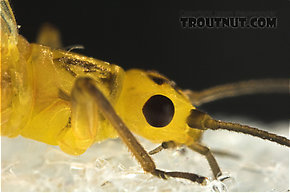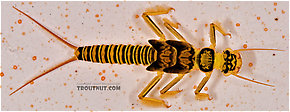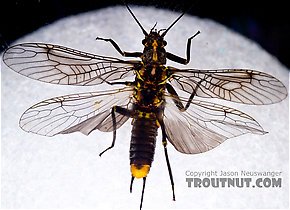Blog & Latest Updates
Fly Fishing Articles
Insects by Common Name


Stonefly Family Perlodidae (Springflies and Yellow Stones)
Taxonomic Navigation -?-
Kingdom
Animalia (Animals)
» Phylum
Arthropoda (Arthropods)
» Class
Insecta (Insects)
» Order
Plecoptera (Stoneflies)
» Family Perlodidae (Springflies and Yellow Stones)
20 genera aren't included.
Common Names
| Match | Common Name |
| Springflies and Yellow Stones | |
| Medium Browns and Yellows |
The family can be broken down into two groups:
The subfamily Isoperlinae, or Stripetails - contains five genera; three are monotypic (Monotypic: a taxonomic level containing a single lower level. Example - a genus consisting of a single species.), one has two species, and the very large and ubiquitous Isoperla genus containing most of the species anglers call Little Yellow Stones or Yellow Sallies. These are common hatches on our freestone streams during late spring and Summer.
The subfamily Perlodinae, or Springflies - contains thirty two genera in many sizes and colors including some important medium browns, yellows, and even some olives. It also includes the large Skwala Springflies of the West. As their group name implies, these are most common in the late winter through Spring.
Pictures of 27 Stonefly Specimens in the Family Perlodidae:
Isoperla (Stripetails and Yellow Stones) Stonefly Adult View 14 PicturesA friend brought me this stonefly to photograph. He found it floating on the surface of a trout stream with its wings in a crippled position.
View 14 PicturesA friend brought me this stonefly to photograph. He found it floating on the surface of a trout stream with its wings in a crippled position.
 View 14 PicturesA friend brought me this stonefly to photograph. He found it floating on the surface of a trout stream with its wings in a crippled position.
View 14 PicturesA friend brought me this stonefly to photograph. He found it floating on the surface of a trout stream with its wings in a crippled position.Collected May 5, 2006 from Salmon Creek in New York
Added to Troutnut.com by Troutnut on May 22, 2006
Added to Troutnut.com by Troutnut on May 22, 2006
Isogenoides hansoni (Appalachian Springfly) Stonefly Nymph View 11 PicturesThis large Perlodidae stonefly was a strikingly bright yellow color, more so than any other insect I've seen. I didn't enhance it much. See the discussion threads to follow how we identified this specimen, which was listed incorrectly for several years.
View 11 PicturesThis large Perlodidae stonefly was a strikingly bright yellow color, more so than any other insect I've seen. I didn't enhance it much. See the discussion threads to follow how we identified this specimen, which was listed incorrectly for several years.
 View 11 PicturesThis large Perlodidae stonefly was a strikingly bright yellow color, more so than any other insect I've seen. I didn't enhance it much. See the discussion threads to follow how we identified this specimen, which was listed incorrectly for several years.
View 11 PicturesThis large Perlodidae stonefly was a strikingly bright yellow color, more so than any other insect I've seen. I didn't enhance it much. See the discussion threads to follow how we identified this specimen, which was listed incorrectly for several years.Collected April 19, 2006 from Mongaup Creek in New York
Added to Troutnut.com by Troutnut on April 21, 2006
Added to Troutnut.com by Troutnut on April 21, 2006
Female Helopicus subvarians (Springfly) Stonefly Adult View 11 PicturesI caught this female during her egg-laying flight.
View 11 PicturesI caught this female during her egg-laying flight.
 View 11 PicturesI caught this female during her egg-laying flight.
View 11 PicturesI caught this female during her egg-laying flight.Collected June 7, 2007 from the West Branch of the Delaware River in New York
Added to Troutnut.com by Troutnut on June 8, 2007
Added to Troutnut.com by Troutnut on June 8, 2007
Recent Discussions of Perlodidae
Helopicus subvarians (Stonefly) common in New York waters! 6 Replies »
I have observed the Helopicus subvarians (springtime stonefly) for over 30 years on many of New Yorks Rivers, such as Beaverkill/Willowwemoc, Ausable (both east and west branch), West Canada Creek, and several others. Most of this time I believed it to be Acroneura nigrita ( Black Willow Stonely) as described by Ernest Schwiebert (Nymphs). Very distinct about the coloring of this Staonely is the last (rearward) sternites are very yellow (Ausable almost orange) while the riest is mostly black top and bottom. The thorax is again very distinctly marked with yellow (orange) with black on top. It is a most beautiflul stonefly, and is see it in May and June. It is well represented by the Montana Nymph is Black with yellow.
ReplyArcynoptryx compacta name change 6 Replies »Posted by Bnewell on Jul 26, 2012 in the species Arcynopteryx compacta
Last reply on Jul 28, 2012 by Entoman
In a recent publication the name of this species was changed to Skwala compacta.
ReplySkwala 9 Replies »The genus Skwala (Short-winged Springflies) of the Perlodidae family should be included in any comprehensive list of important stoneflies for the western flyfisher. Though often mistakenly thought of as perlids (Golden Stones) that happen to hatch early, they are actually quite different and often far more important than their highly publicized cousins on many western rivers. Perhaps the most significant factors regarding the growing recognition of their importance are their inhabiting tailwaters and the lengthening of trout seasons, both relatively recent phenomena. This goes a long way in explaining the scant mention they have received in older angling literature.
Where Skwalas are found in such incredible numbers are mostly the low elevation tailwaters. These rivers flowed much too warm in the Summer and early Fall to sustain trout fisheries prior to the extensive dam projects of the 50's and 60's. So... nobody in our fraternity paid much attention to the bug life. Whether the Skwalas were already there and adapted to the cooler water or migrated from higher elevations is an interesting conjecture. A popular theory is that these tailwaters are rapidly evolving ecosystems that are only now settling into their established fauna that include the now very important Skwala and ... trout! It makes sense to me.
In CA, their emergence runs for a few weeks to a month and can start as early as mid January, depending on the year. Years in which we miss a February "false spring" following a cold January can delay them until the end of the month running well into March. These dates are undoubtedly much later north of Southern Oregon and east of the Sierra's. They are reported even later in the northern Rockies.
What little information that does exist about the genus Skwala in flyfishing literature is often misplaced with other genera or treated in short footnotes as insignificant. There also seems to be a lot of confusion among knowledgable anglers between this genus and Paraperla, which is of an entirely different family (Chloroperlidae). Ernest Schwiebert in his revised addition of "Nymphs" listed Paraperla paralella as a hatch of some significance out west. In footnotes related to this species, he mentions that some entomologists are considering placing this species in the Skwala genus. This footnote is the only reference to Skwala in the entire book and the genus isn't listed in the extensive index covering hundreds of far more obscure species. His comment only adds to the confusion. Especially since he accurately describes Paraperla's physical characteristics, which are at odds with those of Skwala. Moving species among genera while retaining their specific names is one thing but moving them to entirely different families already in existence is problematic. Perhaps the confusion comes from shared specific names by the two different genera in older taxonomies that do list Skwala paralella as a valid name that has since been dropped.
What we call them aside, there is no confusion about the differences in their appearance. Paraperlas are very slender (not unlike the dark winter stones) and less noticeably segmented than would normally be associated with Perlodids. They are more monochromatic and usually lack pronounced patterning on their dorsal surfaces. They cannot be mistaken for the much stockier and stipple backed Skwalas, who's tails and antenna are also more than twice as long.
Because of this confusion over nomenclature maybe reports by anglers of "Skwalas" from other regions of the West that are described as strongly olivaceous in color are in fact referring to Chloroperlids and not Perlodids? This needs to be sorted out.
Lovers of large cobble bottomed riffles and runs, their behavior is consistent with other large stoneflies except that they are more prone to floating long distances as they placidly oviposit... And with the exception of the pteronarcids (Salmon Fly) in some locations, they do it in larger numbers. There is usually no challenge to them for the fishes attention until the March Browns (Rhithrogena morrisoni) begin to appear a few weeks later. Their flights occur during the warmest part of the day which usually means in the afternoons. I have also fished over impressive flights around the lunch hour. They finish well before dark.
The female nymphs run approx. 22 mm in body length with tails and antenna as long as their bodies. The males are substantially smaller. In build and markings, they superficially resemble the larger Perlids (Golden Stones), but are less stout and colored a bit differently with greater contrast between ventral and dorsal surfaces. The large perlid nymphs tend to be dark patterned amber (oak turkey wing) dorsally over pale amber ventrals; Skwala nymphs are even darker patterned brown (turkey tail) over primrose.
The adults have smoky brown wings, brown legs, and primrose abdomens ribbed with brown or the reverse. The males are brachypterous (very short winged). Their curiously marked sternites are perfectly matched by the yellow/black variegated chenille when its wrapped on a hook (to bad it doesn't float well). Gravid females carry black, pea shaped egg clusters off the tips of their abdomens that are larger in diameter than their abdomens. Folding a section of black foam to stick out beyond the hook bend is a wise addition to some of your dry imitations in case you find fish attracted to the those that have yet to drop their eggs.
Unfortunately, another trait they share with other large stonefly genera is their propensity for cyclic population densities. Frankly, many of the western large stonefly genera appear to be in a down cycle from their peaks of a few years ago in a lot of locations, and their present populations on some of the rivers I fish are nothing like the "blizzards" we saw in the 70's.
ReplyWhere Skwalas are found in such incredible numbers are mostly the low elevation tailwaters. These rivers flowed much too warm in the Summer and early Fall to sustain trout fisheries prior to the extensive dam projects of the 50's and 60's. So... nobody in our fraternity paid much attention to the bug life. Whether the Skwalas were already there and adapted to the cooler water or migrated from higher elevations is an interesting conjecture. A popular theory is that these tailwaters are rapidly evolving ecosystems that are only now settling into their established fauna that include the now very important Skwala and ... trout! It makes sense to me.
In CA, their emergence runs for a few weeks to a month and can start as early as mid January, depending on the year. Years in which we miss a February "false spring" following a cold January can delay them until the end of the month running well into March. These dates are undoubtedly much later north of Southern Oregon and east of the Sierra's. They are reported even later in the northern Rockies.
What little information that does exist about the genus Skwala in flyfishing literature is often misplaced with other genera or treated in short footnotes as insignificant. There also seems to be a lot of confusion among knowledgable anglers between this genus and Paraperla, which is of an entirely different family (Chloroperlidae). Ernest Schwiebert in his revised addition of "Nymphs" listed Paraperla paralella as a hatch of some significance out west. In footnotes related to this species, he mentions that some entomologists are considering placing this species in the Skwala genus. This footnote is the only reference to Skwala in the entire book and the genus isn't listed in the extensive index covering hundreds of far more obscure species. His comment only adds to the confusion. Especially since he accurately describes Paraperla's physical characteristics, which are at odds with those of Skwala. Moving species among genera while retaining their specific names is one thing but moving them to entirely different families already in existence is problematic. Perhaps the confusion comes from shared specific names by the two different genera in older taxonomies that do list Skwala paralella as a valid name that has since been dropped.
What we call them aside, there is no confusion about the differences in their appearance. Paraperlas are very slender (not unlike the dark winter stones) and less noticeably segmented than would normally be associated with Perlodids. They are more monochromatic and usually lack pronounced patterning on their dorsal surfaces. They cannot be mistaken for the much stockier and stipple backed Skwalas, who's tails and antenna are also more than twice as long.
Because of this confusion over nomenclature maybe reports by anglers of "Skwalas" from other regions of the West that are described as strongly olivaceous in color are in fact referring to Chloroperlids and not Perlodids? This needs to be sorted out.
Lovers of large cobble bottomed riffles and runs, their behavior is consistent with other large stoneflies except that they are more prone to floating long distances as they placidly oviposit... And with the exception of the pteronarcids (Salmon Fly) in some locations, they do it in larger numbers. There is usually no challenge to them for the fishes attention until the March Browns (Rhithrogena morrisoni) begin to appear a few weeks later. Their flights occur during the warmest part of the day which usually means in the afternoons. I have also fished over impressive flights around the lunch hour. They finish well before dark.
The female nymphs run approx. 22 mm in body length with tails and antenna as long as their bodies. The males are substantially smaller. In build and markings, they superficially resemble the larger Perlids (Golden Stones), but are less stout and colored a bit differently with greater contrast between ventral and dorsal surfaces. The large perlid nymphs tend to be dark patterned amber (oak turkey wing) dorsally over pale amber ventrals; Skwala nymphs are even darker patterned brown (turkey tail) over primrose.
The adults have smoky brown wings, brown legs, and primrose abdomens ribbed with brown or the reverse. The males are brachypterous (very short winged). Their curiously marked sternites are perfectly matched by the yellow/black variegated chenille when its wrapped on a hook (to bad it doesn't float well). Gravid females carry black, pea shaped egg clusters off the tips of their abdomens that are larger in diameter than their abdomens. Folding a section of black foam to stick out beyond the hook bend is a wise addition to some of your dry imitations in case you find fish attracted to the those that have yet to drop their eggs.
Unfortunately, another trait they share with other large stonefly genera is their propensity for cyclic population densities. Frankly, many of the western large stonefly genera appear to be in a down cycle from their peaks of a few years ago in a lot of locations, and their present populations on some of the rivers I fish are nothing like the "blizzards" we saw in the 70's.
There is 1 more topic.
Your Thoughts On Perlodidae:
Top 10 Fly Hatches
Top Gift Shop Designs
Eat mayflies.
Top Insect Specimens
Miscellaneous Sites
Troutnut.com is copyright © 2004-2024 Jason
Neuswanger (email Jason). See my FAQ for information about use of my images.
 privacy policy
privacy policy
